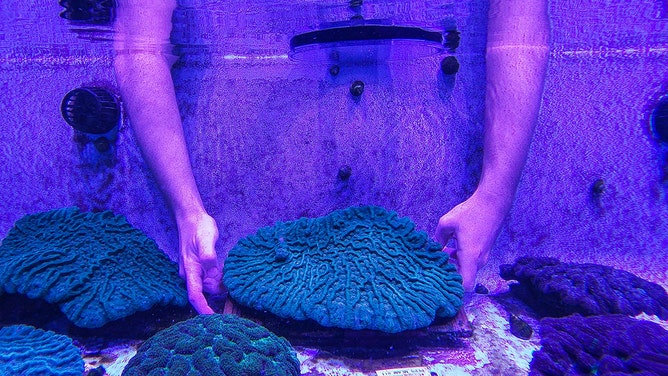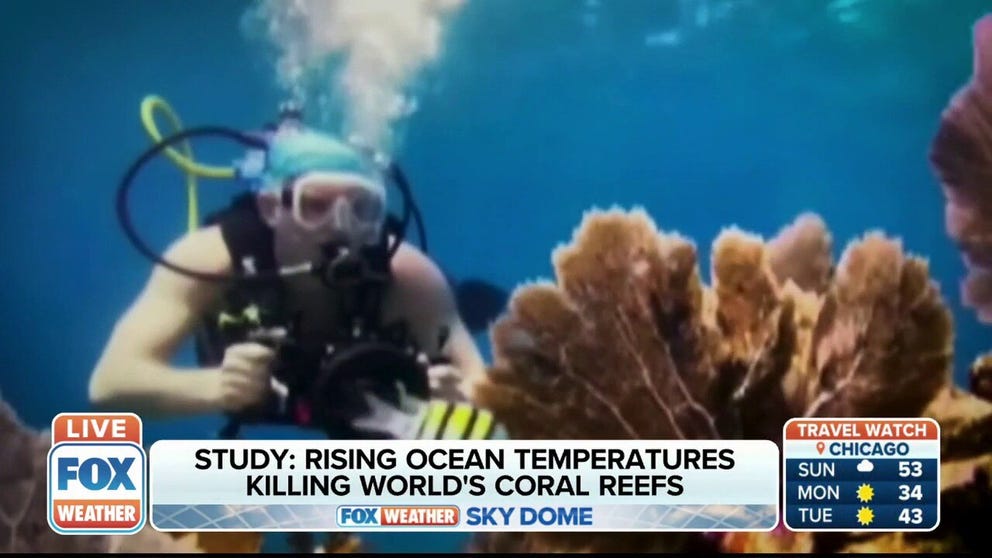This could be key to saving North America’s only barrier reef
The Florida Coral Rescue Center holds about 18 different species of reef-building corals that prevent shoreline erosion and help protect the Keys from hurricanes and flooding
Study: Rising ocean temperatures killing world's coral reefs
The largest global analysis of coral reef health ever completed indicates that rising ocean temperatures resulted in a 14 percent loss of global corals.
ORLANDO, Fla. -- A nondescript warehouse in Orlando, Florida, could be the key to saving North America’s only barrier reef.
With the effort from two theme park rivals -- SeaWorld and Disney -- and many others, the Florida Coral Rescue Center was created.
"They’re incredibly important not only for the chemical balance of the ocean, but the barrier reefs protect the coastlines," said Jim Kinsler, SeaWorld curator and Florida Coral Rescue Center facility manager.
The Florida Coral Rescue Center is currently the largest facility of its kind in the United States. The sanctuary holds about 18 different species of reef-building corals that prevent shoreline erosion and help protect the Florida Keys from hurricanes and flooding.
"So when a hurricane comes through, the storms produce giant waves, and when they hit the coral reef, it greatly reduces the wave size and helps protect your houses," Disney Conservation Science Manager Dr. Andy Stamper said.
The Florida Reef Tract lies approximately six miles from shore and stretches roughly 370 miles along the coast from the Dry Tortugas up through the Palm Beaches.
Even at their immense size, the world’s third-largest reef system collapses as climate changes.
"The corals start to starve, and that’s a big stressor on them. And that’s happening almost yearly now because of the warming temperatures of the waters," Stamper said.
And as water temperatures rise, unprecedented coral bleaching takes hold.
"If it does get too warm, usually over 90 degrees, the corals can bleach, and they’ll lose their zooxanthellae, their symbiont, their algae component of their cells. They turn white and die," SeaWorld Aquarium Supervisor Justin Zimmerman said.

A staff member works on restoring Florida's coral reef at Florida Coral Rescue Center in Orlando, Florida, on September 20, 2021.
(CHANDAN KHANNA / Getty Images)
In what NOAA calls the "largest global analysis of coral reef health ever undertaken," rising ocean temperatures have resulted in a 14% loss of global corals. They also found indications of coral resilience in some locations.
"People around the world depend on healthy coral reefs and the services they provide for food, income, recreation, and protection from storms," said Jennifer Koss, director of NOAA’s Coral Reef Conservation Program. "It is possible to turn the tide on the losses we are seeing, but doing so relies on us as a global community making more environmentally conscious decisions in our everyday lives."
The natural wonder is now vulnerable and ravaged by a previously unknown disease. Initially found in the Upper Keys in 2014, stony coral tissue disease has since spread to over half of the Florida Reef Tract.
"It’s really devastating because, unlike other diseases which just kind of make the coral sick, and they can grow back, this one completely destroys the coral head and in high numbers. So it’s really endangering the reef," Stamper said.
The mission now is to preserve the rescued coral and protect their genetic makeup and repopulate the reef one day.
"That’s the whole point of this coral rescue effort is to try and breed resistant corals that have maximum genetic diversity and can be resilient to stress out in the coral reef," said Andrew Walker, president and CEO of the Fish and Wildlife Foundation of Florida.
It’s a growing need for a reef that has lost half of its coral over the last two centuries.
"We prefer the sexual reproduction because there you get new genotypes and the potential to have corals that are less susceptible to global warming," Zimmerman said.
Reefs are described as the rainforests of the ocean housing over 25% of ocean animals while only taking up only .1% of the ocean floor.
But it’s not just marine life and their homes that they protect. They protect ours as well.
